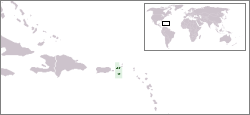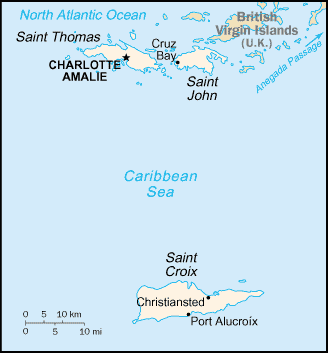United States Virgin Islands
2007 Schools Wikipedia Selection. Related subjects: North American Geography
|
|||||
| National motto: "United in Pride and Hope" | |||||
 |
|||||
| Official language | English | ||||
| Capital | Charlotte Amalie | ||||
| Head of State | George W. Bush | ||||
| Governor | Charles Wesley Turnbull | ||||
| Area - Land - % water |
Ranked 202nd 346.36 km² 1% |
||||
| Population - Total ( 2005) - Density |
Ranked 191st 112,000 (July 2005 est.) 354/km² |
||||
| Independence | none (territory of the U.S.), Revised Organic Act of 22 July 1954 | ||||
| Currency | U.S. dollar (USD) | ||||
| Time zone | UTC-4 (no DST) | ||||
| National anthem | Virgin Islands March | ||||
| Internet TLD | .vi | ||||
| Calling Code | +1 (340) | ||||
The United States Virgin Islands are a group of islands in the Caribbean that are an insular area of the United States. The islands are geographically part of the Virgin Islands and are located in the Leeward Islands of the Lesser Antilles. The U.S. Virgin Islands consist of the four main islands of St. Thomas, St. John, St. Croix, and Water Island, and many smaller islands. It is the only part of the United States where traffic drives on the left. The total land area of the territory is 346.36 km² (133.73 sq mi). As of the 2000 census the population was 108,612 .
In Denmark, they are also referred to as The Former Danish West Indian Islands (De tidligere Dansk Vestindiske Øer).
History
The Virgin Islands were originally settled by the Ciboney, Carib, and Arawaks. The islands were named by Christopher Columbus on his second voyage in 1493 for Saint Ursula and her virgin followers. Over the next three hundred years, the islands were held by many European powers, including Spain, Britain, the Netherlands, France, the Knights of Malta, and Denmark.
The Danish West India Company settled on Saint Thomas in 1672, on Saint John in 1694, and purchased Saint Croix from France in 1733. The islands became royal Danish colonies in 1754, their name in Danish translating as Jomfruøerne. Sugarcane, produced by slave labor, drove the islands' economy during the 18th and early 19th centuries, until the abolition of slavery by Governor Peter von Scholten on July 3, 1848.
For the remainder of the Danish time, the islands were not economically viable and significant transfers were made from the Danish state budgets to the authorities in the islands. An attempt to sell the islands to the United States was made early in the 20th century, but a deal proved elusive. A number of reforms in the hope of reviving the islands' economy were attempted, but none having great success. The onset of World War I brought the reforms to a close, and again left the islands isolated and exposed.
During the submarine warfare phases of the First World War, the United States, fearing that the islands might be seized by Germany as a submarine base, once again approached Denmark to sell the islands to the United States. After a few months of negotiations a selling sum of $25 million was agreed. The Danish Crown may have felt some pressure to accept the sale, thinking that the United States would seize the islands if Denmark was invaded by Germany. However, at the same time the economics of continued possession weighed heavily on the minds of Danish decision makers, and a bipartisan consensus in favour of selling emerged in the Danish parliament. A subsequent referendum held in late 1916 confirmed the decision to sell by a wide margin. The deal was thus ratified and finalized on January 17, 1917, when the United States and Denmark exchanged their respective treaty ratifications. The U.S. took possession of the islands on March 31, 1917, when the territory was renamed the U.S. Virgin Islands.
U.S. citizenship was granted to the inhabitants of the islands in 1927.
Administrative divisions
The U.S. Virgin Islands is administratively divided into 2 districts and subdivided into 20 sub-districts.
The districts include: St. Croix, and St. Thomas - St. John.
The sub-districts include: Anna's Hope Village, Central, Charlotte Amalie, Christiansted, Coral Bay, Cruz Bay, East End (St. Croix), East End (St. John), East End (St. Thomas), Frederiksted, Northcentral, Northside, Northwest, Sion Farm, Southcentral, Southside, Southwest, Tutu, Water Island, and West End.
Geography
The U.S. Virgin Islands are located in the Caribbean Sea and the Atlantic Ocean, about 50 miles east of Puerto Rico. The territory consists of four main islands: Saint Thomas, Saint John, Saint Croix, and Water Island, as well as several dozen smaller islands. The combined land area of the islands is roughly twice the size of Washington, D.C.
The U.S. Virgin Islands are known for their white sand beaches, including Magens Bay and Trunk Bay, and strategic harbors, including Charlotte Amalie and Christiansted. Most of the islands, including Saint Thomas, are volcanic in origin and hilly. The highest point is Crown Mountain, Saint Thomas (474m). Saint Croix, the largest of the U.S. Virgin Islands, lies to the south and has a flatter terrain. The National Park Service owns more than half of Saint John, nearly all of Hassel Island, and many acres of coral reef. (See also Virgin Islands National Park, Virgin Islands Coral Reef National Monument, Buck Island Reef National Monument, Christiansted National Historic Site, and Salt River Bay National Historical Park and Ecological Preserve.)
The Virgin Islands lie on the boundary of the North American plate and the Caribbean Plate. Natural hazards include earthquakes, tropical cyclones, and tsunamis.
Politics
The U.S. Virgin Islands are an organized, unincorporated territory of the United States. Even though they are U.S. citizens, Virgin Islanders cannot vote in U.S. Presidential elections.
The main political parties in the U.S. Virgin Islands are the Democratic Party of the Virgin Islands, the Independent Citizens Movement (ICM), and the Republican Party of the Virgin Islands. Additional candidates run as independents.
At the national level, the U.S. Virgin Islands elects a delegate to Congress from its at large congressional district. However, the elected delegate while able to vote in committee cannot participate in floor votes.
At the territorial level, fifteen senators—seven from the district of Saint Croix, seven from the district of Saint Thomas and Saint John, and one senator at-large who must be a resident of Saint John—are elected for two-year terms to the unicameral Virgin Islands Legislature.
The U.S. Virgin Islands has elected a territorial governor every four years since 1970. Previous governors were appointed by the President of the United States.
The U.S. Virgin Islands has both a District Court and a Superior Court. Judges are appointed by the President and the governor respectively.
The United States Congress has organized several local referenda to aid in the islands' self-determination. As with Puerto Rico, the residents have been given the choice of independence, status quo, or statehood; however, these measures have failed to attract sufficient civic interest or voter turn-out to produce even a noteworthy plurality, much less a majority, and thus the islands will retain their current territorial status for the foreseeable future. It is theorized that Puerto Rican requests for political self-determination might serve as a catalyst for political interest in the U.S. Virgin Islands, as well as in other American territories.
With much controversy, these efforts by the federal government to normalize the unincorporated territory's status are completely discounted by the United Nations Committee on Decolonization, and the U.S. Virgin Islands are currently in the United Nations list of Non-Self-Governing Territories.
Economy
Tourism is the primary economic activity. The islands normally host 2 million visitors a year, many of whom visit on cruise ships. The manufacturing sector consists of petroleum refining, textile, electronics, rum distilling, pharmaceutical, and watch assembly plants. The agricultural sector is small, with most food being imported. International business and financial services are a small but growing component of the economy. Hovensa, one of the world's largest petroleum refineries, is located on Saint Croix.
The islands are subject to tropical storms and hurricanes. In recent history, substantial damage was caused by Hurricane Hugo in 1989 and Hurricane Marilyn in 1995. The islands were also struck by Hurricane Bertha in 1996, Hurricane Georges in 1998 and Hurricane Lenny in 1999, but damage was not as severe in those hurricanes.
Trivia
- Three of the four U.S. Virgin Islands have nicknames often used by locals. St. Thomas - "Rock City", St. John - "Love City", and St. Croix - "Twin City"
- Though traffic drives on the left side of the road in the U.S. Virgin Islands, almost all vehicles are left hand drive (as they are imported from the United States). See Right Hand Driving: Caribbean
- Public access to beaches is considered a civil right. Public access over land however, is not.
- The U.S. Virgin Islands are permanently on Atlantic Standard Time and do not participate in Daylight Saving Time. When the U.S. is on Standard Time, the U.S. Virgin Islands are one hour ahead of the U.S. Eastern Time Zone. When the U.S. is on Daylight Saving Time, the U.S. Virgin Islands follow the same clock as Eastern Time.


